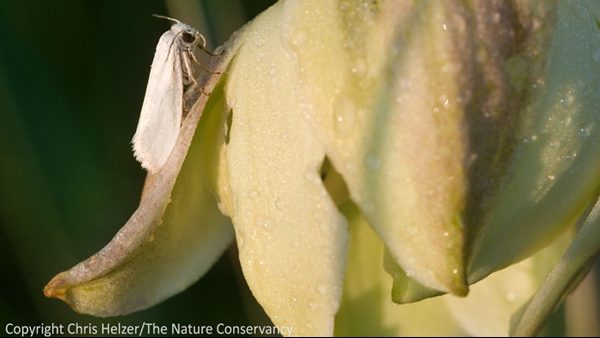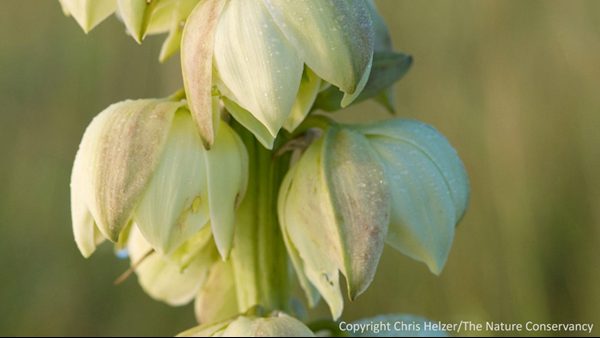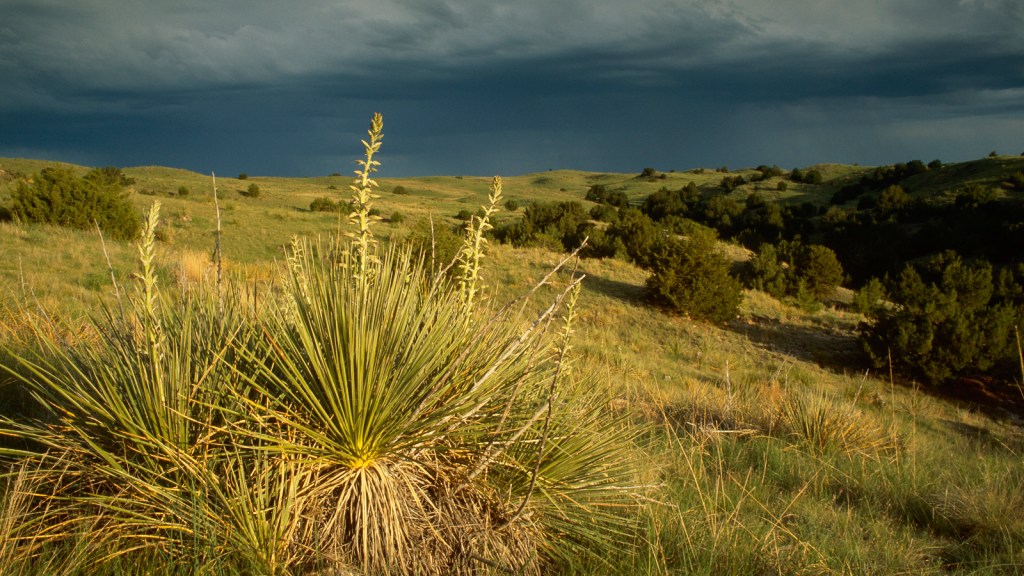For more than 40 million years there has been a relationship between yucca plants and yucca moths. It’s a particularly important one because neither the yucca or the moth can survive without the other. The moth’s larvae depend on the seeds of the yucca plant for food, and the yucca plant can only be pollinated by the yucca moth.
In the central United States, soapweed yucca (Yucca glauca) is pollinated by a moth known as Tegeticulla yuccasella. Each spring, adult moths emerge from underground cocoons and the males and females meet up with each other on yucca plants to mate.
When a female is ready to lay eggs, she first goes to a yucca flower to collect pollen. Unlike most moth species, yucca moths have two short tentacles near their mouth that they use to scrape pollen from the anthers of the flower. As she collects the sticky pollen, the yucca moth packs it into a ball and sticks it under her head. She then flies off to another yucca flower.

When she arrives at the second yucca flower, usually one that has very recently opened, she goes straight to the bottom to find the ovary. She opens a small hole in the ovary and lays her eggs inside.
Once the eggs are laid, she scrapes a small amount of pollen from her sticky ball with her tentacles, walks to the stigma of the flower, and packs the pollen into tiny depressions within the style.
She may then return to the ovary of the same flower to lay more eggs or fly to another flower. Either way, before she leaves the flower, she marks it with a pheromone (a chemical other moths can sense). The scent marker will tell later visitors that they’re not the first to reach the flower, and they will either lay fewer eggs than the first moth, or none at all, depending upon how many moths have left their scent already.
This helps moderate the number of larva that hatch within each flower, and prevents the plant from aborting the flower altogether, which it will do if too many eggs are laid.

When the eggs hatch, the larvae feed on yucca seeds within the fruit. Typically, there are more seeds than the larvae in a particular flower can eat (since the plant aborts flowers that are too heavily laden with eggs). When the larvae finish eating, they burrow out of the fruit—usually during rain events, interestingly—and burrow down into the ground to make their cocoon and wait until the next spring when the whole process plays out again.
As far as anyone knows, and it’s been studied since the 1870s, no other species besides the moth pollinates yucca flowers. Similarly, yucca moth larvae don’t feed on anything other than yucca seeds. So each species depends upon each other for survival, and both benefit from the relationship.
It’s a beautiful thing.
If you want to read about some additional interelationships with yucca, the moth, and other insects, you might be interested in this article by Laura Hebert.
Acknowledgments: Thank you to Mary Ann Feist for help with this post.
Read more of Chris Helzer’s writings at The Prairie Ecologist blog, where this post originally appeared.




Just FYI, the link to Olle Pellmyr’s article is broken, and the text of Laura Hebert’s article is inaccessible without a Researchgate account.
Archetypal memory/ collective consciousness. The first scripture written was nature, from which to understand God. This moth provides just that.
You know how bees and birds seems to have an instinctual concept of migration, jobs to be done etc.. Where do they get that from? Is it a collective consciousness? How does that collective consciousness occur? Is it somehow passed from one individual to the next?
Well it seems that in this type of insect, the yucca moth, that only lives one life cycle and almost every bit of it is separated from any other of it’s species, except for one small moment where they breed, and they breed with another moth who also has never had any contact with any of it’s species. They have an indwelling understanding of a concept that seems to be part of them, and not aqquired.
This yucca moth lives in the ground as a pupae most of it’s life, and then emerges as a moth, immediately flies to a yucca blossom, and immediately mates, at which point the male dies. The female does not live much longer and so does not eat, but immediately collects the pollen from the yucca plant into a ball under her chin (unlike other insects that pollinate by having the pollen stick to them and passively transport and pollinate other plants)
She then flies from yucca to yucca looking for (or smelling for…because the other females leave their pheromones behind after they have laid their eggs in a yucca) a yucca that does not yet have eggs deposited in them. When she finds such a yucca she deposits her eggs in a fruiting body and then with great care inserts the pollen into the ova of that plant. This ensures that that fruit will mature and provide food for her eggs. As the fruit mature the larva eat it and develop. When the fruit is grown it drops to the earth, where the larva burrow into the ground and live out most of their lives. As soon as the female is finished laying her eggs, she dies.
HERE IS THE POINT.
1. The moth has no contact in which to impart to her these behaviors. It is part of her makeup.
2.In humans ever since man was prehistoric man, they have worshiped some greater being. Sought favor with this greater being. Tried to understand what the greater being wanted. I am proposing it is ingrained in us to seek that which we are from, exactly for the same reason that the moth does, to continue to live.
That is my argument.
That humans seek God not because they are contaminated with the belief that God exists from other humans, but because within us is this NEED, this yearning for God that was put there by God to help us find God and live.